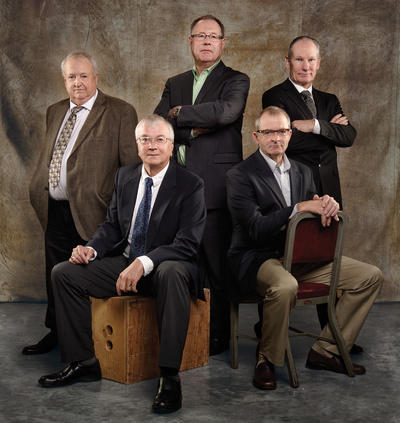
From the Class of 1980 are Don Woods, David Foo, Rick Jensen, Bruce Standing and Kim Joslin.
Jason Stang
Nov. 16, 2016

From the Class of 1980 are Don Woods, David Foo, Rick Jensen, Bruce Standing and Kim Joslin.
Jason Stang
Back when hair was large, jeans were acid-washed and Walkmans were gnarly, a group of newly minted engineers from the University of Calgary made a tacit pact to stick together. They were part of the 40-strong graduating class of 1980’s Chemical Engineering program and, 36 years later, their friendships are not only intact, but their collective drive and passion has made a meaningful difference to their alma mater and beyond.
This week, the Schulich School of Engineering opened its doors to a newly renovated and expanded hub for teaching, learning and research. The $174-million, state-of-the-art complex will enable experiential learning opportunities for undergraduate and graduate students, and encourage collaboration, mentorship and entrepreneurial thinking in a variety of student-oriented spaces, labs and an expanded Career Centre. Design and construction of the project was funded by government, corporate and individual donations, including a significant gift from the aforementioned group of devoted alumni.
Dave Foo, Rick Jensen, Kim Joslin, Bruce Standing, Don Woods, Donald Wong, Kenneth Hall, Wayne Sim, Kelly Edwards, James Beckie and Barbara McDonald met when they shared classes and study space in the late 1970s as they pursued degrees in chemical engineering. While they no doubt had moments of fun as classmates, Jensen says it was a mutual striving that drew them close and, nearly four decades later, continues to bind them.
Supporting one another like family
“There was a shared desire to work hard and make a mark in the world, combined with a unique blending of personality types,” says Jensen. “There’s also always been a feeling that we’ve hung together and supported one another like family — that theme really permeated the classroom.” Jensen and various members of his cohort have since gathered a few times every year for lunches, supporting charity runs and other events.
When classmate Wayne Sim approached Jensen and the others asking about making a philanthropic gift to support the new complex, the idea quickly snowballed.
“A lot of us have sons and daughters who have attended the University of Calgary, some of us are thinking about our grandchildren’s futures, and we’ve all benefited from the university,” says Jensen. “It was a natural fit to make this kind of contribution.”
Engineering grows more interconnected, demanding
Jensen and his friends are well aware of how much more complicated the world of engineering has become in terms of technical challenges, regulations, awareness and observance of environmental compliance, etc., since they graduated. All of that means that, these days, the most successful engineers and engineering students are those who, he believes, have a broader perspective and are able to evolve their abilities in different ways rather than just sticking strictly to the discipline.
The Class of 1980’s contribution to the Schulich School’s transformative new complex is lasting, practical proof of the group’s belief that dynamic teaching, hands-on learning and creative collaboration are key to developing engineers capable of solving complex problems that will benefit Alberta and the world. It is proof, too, that an engineering classroom is a pretty good place to make life-long friends.
About Energize: The Campaign for Eyes High
Energize: The Campaign for Eyes High is the University of Calgary’s most ambitious fundraising campaign to date. Funds raised through the campaign will support student experiences, research outcomes and community connections. Together we are fueling transformational change for the University of Calgary, our city, and beyond—inspiring discovery, creativity and innovation for generations to come. Formally launched in April 2016, the campaign is more than halfway to its overall goal of $1.3 billion.